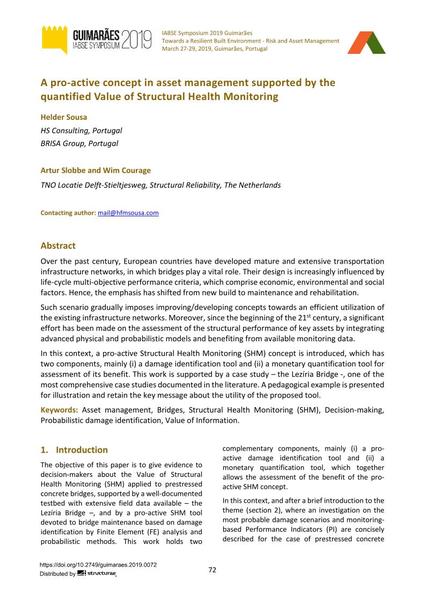A pro-active concept in asset management supported by the quantified Value of Structural Health Monitoring

|
|
|||||||||||
Bibliographic Details
| Author(s): |
Helder Sousa
Artur Slobbe (TNO Locatie Delft-Stieltjesweg, Structural Reliability, The Netherlands) Wim Courage (TNO Locatie Delft-Stieltjesweg, Structural Reliability, The Netherlands) |
||||
|---|---|---|---|---|---|
| Medium: | conference paper | ||||
| Language(s): | English | ||||
| Conference: | IABSE Symposium: Towards a Resilient Built Environment Risk and Asset Management, Guimarães, Portugal, 27-29 March 2019 | ||||
| Published in: | IABSE Symposium Guimarães 2019 | ||||
|
|||||
| Page(s): | 72-79 | ||||
| Total no. of pages: | 8 | ||||
| DOI: | 10.2749/guimaraes.2019.0072 | ||||
| Abstract: |
Over the past century, European countries have developed mature and extensive transportation infrastructure networks, in which bridges play a vital role. Their design is increasingly influenced by life-cycle multi-objective performance criteria, which comprise economic, environmental and social factors. Hence, the emphasis has shifted from new build to maintenance and rehabilitation. Such scenario gradually imposes improving/developing concepts towards an efficient utilization of the existing infrastructure networks. Moreover, since the beginning of the 21st century, a significant effort has been made on the assessment of the structural performance of key assets by integrating advanced physical and probabilistic models and benefiting from available monitoring data. In this context, a pro-active Structural Health Monitoring (SHM) concept is introduced, which has two components, mainly (i) a damage identification tool and (ii) a monetary quantification tool for assessment of its benefit. This work is supported by a case study – the Lezíria Bridge -, one of the most comprehensive case studies documented in the literature. A pedagogical example is presented for illustration and retain the key message about the utility of the proposed tool. |
||||
| Keywords: |
bridges asset management value of information structural health monitoring (SHM) decision-making Probabilistic damage identification
|
||||
